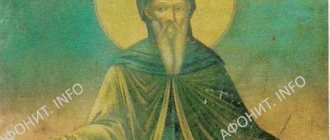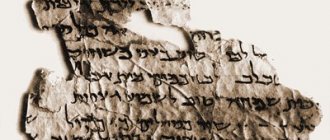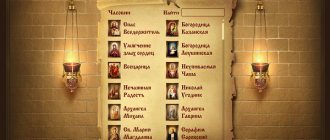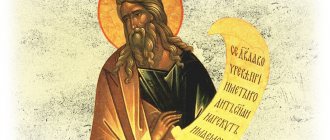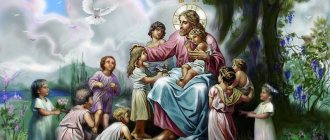Typikon (Church Slav. Тѷпїко́нъ, Typeкъ), (Greek Τυπικόν from τύπος - sample, charter) - a church liturgical book that establishes the order of Orthodox worship or the Liturgical Charter, which is regulated by general statutory chapters, a monthly book with a description of the connection of the worship of the mobile and fixed annual liturgical circles in Mark's chapters, instructions on the celebration of temple (throne) holidays, rules on fasting, monastery community life, meals and other aspects of church, mainly monastic, life.
Etymology of the name Typicon
The name “Typikon” comes from the Greek τύπος - feature, type, sample, image, icon, model, norm; τυπικός means “made according to a pattern.” Later, the word τύπος acquired the meaning of decree, law . Among the ancient Christian writers Clement of Alexandria, Origen, Basil the Great, this adjective means “symbolic”, “prototypical”. The meaning of the word τύπος is a religious law, a charter of a special nature; for Gregory of Nazianzus it is used in relation to the Creed; for Justinian it means the Divine Law. More accurate than “charter” would be to translate τυπικόν - “official”, lat. ordinarium.
Such an original title of the book, outlining the order of worship, is untranslatable into the Slavic language, which is why it was left without translation. The word "charter" is an inaccurate rendering of the Greek τυπικόν - "charter" corresponds to the Greek διάταξις.
St. Sava the Sanctified (5th century) is the author of the now current Jerusalem Rule, he himself named his own, still brief, Rule, or the companions who wrote it down called it in three words at once: Τύπος καί παράδοσις και νόμος - “model, tradition and law.” St. Theodore the Studite (9th century), a representative of another form of church charter, adopts a charter with the name Ύποτύπωσις - “representation, outline.” The Studio Charter, brought by St. Athanasius of Athos (10th century) on St. Mount Athos, where it received a new processing, received the name Διατύπωσις - “transformation”, “representation”. The oldest surviving complete charter of the Church of St. Constantinople. Sophia (IX-X centuries) supposedly bore the name Συναξάριον - “conciliar”, that is, an index of holidays on which solemn processions with divine services took place. The ancient Sinai copy of the same charter is called Κανονάριον - “collection of rules.” Only from the 11th century. in the designation of the church charter the term τυπικόν already appears, although with other, explanatory names, for example: Συναξάριον ήτοι Τιπικόν. Ancient Slavic manuscripts translate Greek. τυπικόν is either “charter” or “type”, for example among the Old Believers: “Charter, that is, the Church Eye.”
Explanatory Typikon. Part I | Page 1 | Online library
Mikhail Skaballanovich
Intelligent TYPICON
Introductory chapter
History of the Liturgical Rules
From the author
{With. 6}
History is the best teacher, and the deepest interpretation of the Typicon will be its historical interpretation. From the very beginning, intending to give the Typikon mainly a historical explanation, the author wanted to present the latter in the form of exclusively minor comments on individual points and particulars of the Typikon. But if the matter were reduced only to this, then such an interpretation could not be called historical, since history is something whole and unified. Therefore, the author considered it best to include those of the historical explanations of the Typikon that could be combined into one, concluded in one large chapter, so that when considering and analyzing the Typikon itself, without repeating what is said in this last one, limiting ourselves only to references, dwelling only on small ones details. So, the interpretation of the Typikon in its very basics and essential features is already given to the reader in the “Introductory Chapter” to it. This is not a preface to the Explanatory Typikon or an introduction to it, this is the most basic and essential part of it. The author hopes that it is worthy of its honorary title of “chapter” of the Typikon, although only an introductory one. The author is confident that whoever has the desire or patience (one or the other will depend not only on interest in the service, but also on the degree of general church-historical knowledge of the reader), whoever has the patience or desire to read this “chapter”, will lose the veil before the many secrets and riddles of the Typikon, he will feel that the Typikon is half and mostly interpreted and from the subsequent contents of the book will expect an explanation of such, for example, particulars, why at Vespers the special and petitionary litanies are placed after the entrance and repeat the great petitions, or why at the 9th hour During Lent there are only three bows. Only those who read this issue carefully will have to look for answers to such questions in a future edition of our book, unless this reading prepares them to independently resolve such perplexities.
The author is not afraid that the scientific nature of the book will make it difficult for anyone interested in the church Typicon and {p. 7} studying it. Another newspaper article may present, with its abundance of foreign words and special terms, more obstacles to understanding than a simple presentation of this book, which, however, tries not to sacrifice scientific goals, as well as science, which does not seek access to the broad masses.
{With. 8}
A. Liturgical regulations - until complete lists appear
(I–VIII centuries)
Since our liturgical charter has as its task the adaptation of church services to the sacred memories of the day, its compilation - of course, mental at first, and not written - had to begin with the very emergence of sacred memories in Christianity. The appearance of the first sacred memories dates back to the apostolic time, when there was undoubtedly already a liturgical celebration of at least Sunday. So, it is not an exaggeration to say that the first lines of our church charter, setting out precisely the order of Sunday worship, were conceived by the saints themselves. apostles. It is not surprising, therefore, that the old Russian scribes called the Typikon a divinely inspired book. []. It began to be compiled at a time when Christianity had a height of spiritual life that made the appearance of divinely inspired writings possible.
The formation of our worship, which began in the apostolic age, ended, one might say, only in the 16th century, when its charter received its completely current form. And of course, the value of this charter cannot be reduced by the fact that it took one and a half millennia to create it. Quite the contrary. Thanks to such a long period of development of our liturgical charter, the church of different eras could take part in this development, and each of these eras had its own strength and beauty and reflected them on our centuries-old Typikon. And not only the church of different times created the current charter, but also the church of different localities and countries; Consequently, it was developed by the church, not only the Apostolic - but the Catholic {p. 9} both in place and in time. From the pages of the charter one breathes the touching spirit of the ancient church life of either pious Constantinople, or ascetic Egypt and Thebaid. If we take into account the multitude of Old Testament material that has come into our worship, then in these moments we spiritually experience sacred biblical antiquity, “walking with one mind” in the churches of the patriarchs and prophets.
Being a conciliar creation of the church, the liturgical charter, however, was developed primarily only by its most worthy sons. Its immediate authors were people who had no other life other than prayer and fasting, who were allowed by the sweetness of “divine services” to eat once every 5 days and sleep only standing or sitting, who finished their all-night vigils in churches that were set on fire, locked outside by the pagans, people , whose martyr's blood was sometimes mixed with the Eucharistic Blood. The pages of the charter they compiled could not help but be watered with tears of tenderness and the sacrificial blood of confession, which cannot but be felt from there and impart to the book a spirit of special holiness and purity. This is the secret of the deep effect on the soul of Orthodox worship, that those who participate in it perceive the influence of the church of all times in the person of its best forces and live the life of the entire church, and this influence comes not only from the poetry and music of the service, but also from its very architectonics, from these 40-fold “Lord have mercy”, silent bows, interfering with a long pause in singing and reading, from the antiphonal method of singing, etc. The Typikon deals with the actual architectonics and aesthetics of worship. In particular, from a number of ascetics, the current charter adopts its composition by St. Savva, more precisely - “even in Jerusalem the holy monastery of our venerable and God-bearing father Savva.” This is a monastery near Jerusalem in the harsh Judean desert, founded in the 5th century. St. Savva the Consecrated. What share of participation belongs to this reverend in the development of the current charter cannot yet be decided given the current state of scientific sources. But in any case, the birthplace of the current charter is Palestine and its cultivated deserts through the labors of fasting. The creators of our church rules were, therefore, the education of that wilderness that educated Elijah and John the Baptist and prepared the Savior himself for His public ministry. Here the very air was filled with sacred memories. Nearby were the greatest shrines of the Christian world - Jerusalem with the Holy Sepulcher and the Church of the Resurrection, where prayer itself became ardent and where, according to the testimony of one Western traveler of the 4th century. (Sylvia of Aquitaine), when the Gospels of the Passion were read, “the whole people raised such a cry and groan that there was no one who would not be moved to tears at that hour” [].
{With. 10}
Old Testament Jewish worship
In order to correctly imagine the emergence of Christian worship and its order, we must not forget that the apostles and the most significant members of the primal church were Jews, and if their faith and hope were no longer Old Testament, but new, then their prayer and worship could not have gone far beyond the then Jewish forms Worship and ritual are essentially conservative; here holiness is measured by antiquity... The religious inspiration that gripped the apostles and other disciples of Christ after the resurrection of Christ is manifested in the fact that they spend whole days in the temple (“I will take it out in the church”) [], which Christ came to abolish, where, of course, to praise and it was possible to thank (“praising and giving thanks”) to God in Jewish ritual forms. If we pay attention to these forms, it will become clear to us what influence they had on the subsequent development of Christian worship.
Old Testament Temple Worship
Although the essence of Jewish temple worship was sacrifices, a musical and singing element was always included in it, so much so that temple worship seemed to turn everything into music and singing [], and the latter was looked upon as a special type of votive sacrifice next to the material sacrifices [].
Composition of the Typikon
Initially, the Typicon was a monastic charter. Due to the fact that in the 4th and 5th centuries monks were often forbidden to strive for ordination to the holy orders of deacons, priests and bishops, almost nothing is written in the Typikon about the immediate responsibilities of clergy, about the procedure for performing the most important Christian service - the Liturgy (it can performed only by bishops or priests with the blessing of the local ruling bishop), on performing baptisms, funeral services, weddings, consecrations of various things and events, and other requirements.
The modern Typikon of the Russian Orthodox Church contains two conventional sections of 60 chapters each:
First section
a common part
- Chapter 1. The Order of Little Vespers.
- Chapter 2. The rite of Great Vespers, that is, the all-night vigil and Sunday matins, in the same chapter there is the rite of panagia.
- Chapter 3. About the saint who has a vigil every week, and it also contains the rite of blessing the koliva.
- Chapter 4. About the saint who has polyeleos per week.
- Chapter 5. About the saint, we eat at 6 (sixfold) a week.
- Chapter 6. About the vigils that occur throughout the summer.
- Chapter 7. About Great Vespers, Midnight Office and Sunday Matins, when there is no vigil.
- Chapter 8. About liturgies (public meals).
- Chapter 9. About the hallelujah services (when the liturgy is not celebrated), it also contains about the funeral lithium.
- Chapter 10. About reading the Gospel, His interpretations, teachings, patericons, lives of saints; as well as about the days of the Liturgy of St. Basil the Great and the Presanctified Gifts.
- Chapter 11. About the canons of Matins on all days of the week.
- Chapter 12. About the Sabbath service, when “God is the Lord” is sung.
- Chapter 13. About the Saturday service, when Alleluia is sung.
- Chapter 14. About following the dead.
- Chapter 15. About the great saint who has a vigil, or polyeleos on Saturday.
- Chapter 16. About the lamps according to the 9th song throughout the week.
- Chapter 17. About reading kathismas throughout the year.
- Chapter 18. About when the songs will be sung: “We sing to the Lord” and “We sing to the Lord.”
- Chapter 19. About chaos throughout the year.
- Chapter 20. About when “The Most Honest” is sung and when it is not sung.
- Chapter 21. About when to sing figurative, festive or daily antiphons.
- Chapter 22. About the time and order of censing.
- Chapter 23. About the veil of the holy altar, and about the opening of the doors.
- Chapter 24. About lighting candles on the feasts of the Lord and the Mother of God.
- Chapter 25. About the daily lighting of candles.
- Chapter 26. At what time should the brethren not stand with staffs.
- Chapter 27. About the canonarch.
- Chapter 28. About unruly screams.
- Chapter 29. About the revelation of chapters.
- Chapter 30. About not having conversations in church.
- Chapter 31. About the alarm clock.
- Chapter 32. From the rules of the saints the Apostle about the holy 40th, in it about the communion of the Mysteries of Christ, about drinking, washing the lips after communion and about food during Easter week.
- Chapter 33. About fasts (and legalized permissions) throughout the year.
- Chapter 34. About the life of a hostel stay.
- Chapter 35. Discourse on food and drink of Saturday and week, and other days of the week, and also about the second evening meal.
- Chapter 36. About silence at meals, in it about juice and vegetables.
- Chapter 37. About singing, that it is not advisable to sing especially outside the temple.
- Chapter 38. About what is not appropriate to eat outside the common meal.
- Chapter 39. About clothes and shoes.
- Chapter 40. When someone wants to leave the brotherhood.
- Chapter 41. About monastic servants and other fraternal activities.
- Chapter 42. About grave services.
- Chapter 43. About a special house.
- Chapter 44. About doing in the community.
- Chapter 45. On the appropriation of other people's works.
- Chapter 46. About the hospital and hospitality, and about the old and the sick.
- Chapter 47. About the signs of the great, and medium, and small holidays.
Private part
- Chapter 48. Months. This is the largest chapter - it occupies almost 2/3 of the entire volume of the Typikon (out of 1198 pages: pages 118-820 fall on the 48th chapter of the first section of the Typikon alone). Here are detailed diagrams or distinctive features of the sequences of the full daily cycle of services for every holiday and weekday day of the entire year with the full texts of troparions, theotokos, kontakions and other chants and prayers, but more often - only with their initial words (in abbreviation), as well as “ Markov’s chapters”, indicating ways to connect services if in any year a non-movable (immovable, attached to any calendar date) holiday occurs on Saturday, Sunday, on one of the moving holidays, its forefeast, post-feast or celebration. A month consists of 12 months:
- September
- October
- November
- December
- January
- February
- March
- April
- May
- June
- July
- August
Additional part
It contains instructions for changing short weekly prayers, the rules for using which are different for different days of the week, and these prayers themselves.
- chapter 52
- Chapter 53. Full texts of the troparions of dismissal of the Sunday eight voices with their Theotokos, hypakoi and kontakion. Prokeimenon at Matins before the Gospel and at the Liturgy and Alleluia.
- Chapter 54. Pillars of the Gospel, full texts of the Sunday lamps, Gospel stichera and the Theotokos to them.
- chapter 55 The numbers of the apostolic and evangelical principles and their initial words are also given.
- Chapter 56. Kontakia common to saints (texts).
- Chapter 57
- Chapter 58. Trinity songs in eight voices (the Lenten Triodion appendix is repeated). In the same chapter about reading the Apostle and the Gospel.
- Chapter 59
- Chapter 60
Second section
Temple chapters
The temple chapters indicate how to perform services on certain temple holidays, and especially when a temple (throne) holiday coincides with another holiday on the same day. The temple chapters in the Typikon have their own count and are arranged in the same way as the sequences in the second part of the Typikon, namely:
- Chapters 1-24. About the patronal feasts that occur during the singing of the Menaion with Octoechos, that is, from September 1 to the week of the Publican and the Pharisee;
- Chapters 25-47. About the temple holidays that occur during the singing of the Lenten Triodion;
- Chapters 48-58. About the temple holidays that happened during the singing of the Colored Triodion.
Choruses
- Chapter 59. Texts of choruses on the Lord's and Theotokos' feasts, sung on the 9th canto.
Easter
- Chapter 60. From the creation of the world and Adam, the 15th revolution of the indiction (532 years). Easter is sighted according to the key letters of the Slavic alphabet. Lunar current.
History of individual prayers of the usual beginning
Although in its present form it is of rather recent origin, the usual beginning consists, however, of very ancient prayers. The most ancient prayer in it must be recognized as “Lord have mercy.”
"Lord have mercy"
“Have mercy” is the most common prayer exclamation in the psalms; the formula “Lord have mercy” is found in the prophet. Isaiah, Baruch []. The liturgical use of it in the Christian Church is first evidenced by the Apostolic Constitutions (IV–V centuries), where it serves, as in {p. 462} us, in response to the petitions of the liturgical litany []. In the daily services, this formula is borrowed from the litany and, therefore, replaces it.
"Our Father"
The next most ancient prayer in the usual beginning is the Lord's Prayer. But its final doxology came from the lips of the Savior not in the form in which it is used today among us, but, according to its most accepted text by the Evangelist Matthew, in the following form: “For Thine is the kingdom and the power and the glory forever, Amen” [ ]; According to the Evangelist Luke, the Lord’s Prayer has no doxology at all []. In view of this and due to the difference in the transmission of this doxology by different monuments (for example, in the “Teaching of the 12 Apostles” [] it is transmitted even in a briefer form than in the Evangelist Matthew “For Thine is the power and the glory forever”), they now think that in the text ev. Matthew, this doxology came from liturgical practice []. (In the Roman Catholic Church it is used without doxology).
Small Doxology
The next most ancient part of the usual beginning is the doxology, the so-called small one: “Glory to the Father and the Son and the Holy Spirit, now and ever and unto ages of ages Amen ματι, νΰν καί άει και εις τους αιώνας των αιώνων αμήν)", which generally has the widest use in Orthodox worship. It must have arisen from the concluding doxologies of the liturgical prayers: traces of these doxologies can be found repeatedly in the New Testament epistles and in the Apocalypse. The simplest formula for such doxologies is: “To You” or “To Whom be glory (δόξα) forever” []. This formula began to spread in all 3 of its terms, and the expansion of the first concept “To Him” and the last “forever” gave the current small doxology, and the expansion of the second concept “glory” (for example, into such expressions: “glory and honor”, “glory and power”) gave rise to the current litany exclamations (which will be discussed later). The person (“To Him”) to whom the praise is raised in New Testament writing is in most cases one God the Father [] or He through Jesus Christ, for example: “To Him be glory in the Church in Christ Jesus...” [] or “To the only wise God and I will save our glory and majesty, power and authority through Jesus Christ our Lord...” [].
{With. 463}
Sometimes glory is exalted to Christ alone []. The third concept of the primitive short doxology - “forever” - also becomes widespread in apostolic writing: “for ever and ever” [], or “for all generations of ages of ages” [], or: “before all ages and now and to all ages "[]. In this sense, one can say with blzh. Theodoret that the small doxology was “dedicated to the Church by the spectators and ministers of the Word” []. But the first example of a full doxology with the naming of all the persons of the Holy Trinity is found in the dying prayer of the martyr. Polycarp: “through whom (Jesus Christ) glory be unto thee with him and the Holy Spirit...” []. In the same way, the martyrdom of St. Ignatius the God-Bearer ends with the words: “I completed my course in Christ Jesus our Lord, through whom and with whom be glory and power to the Father with the Holy Spirit forever, amen.” The acts of other martyrs of the 2nd century end in a similar way.
In the life of St. Eugenia, who suffered under the emperor Commodus (180–192), finds the doxology almost in its current form; It is said here that the Angels, escorting the martyr to heaven, sang a hymn in which one could hear the words: “Glory and honor to the Father and the Son and the Holy Spirit, now and ever and unto ages of ages, Amen” []. According to St. Irenaeus of Lyons (2nd century), the Gnostics saw in the words “forever and ever” (εις τους αιώνας...), pronounced “by us at thanksgiving,” a designation of eons []. Tertullian (3rd century) says that a Christian who attends spectacles has to “with those lips with which he pronounces Amen in the temple (in sanctum), evaluate the gladiator, say “forever” to someone other than Christ God [] . In these places Irenaeus and Tertullian see an indication of doxology []. Origen says that “prayer should always end with the praise of God through Christ in the Holy Spirit” []. In the canons of Hippolytus and the Egyptians (3rd century), the formula of doxology is the same as that of Polycarp, but along with it the current one is also found, and both sometimes together, for example, “through whom (Jesus Christ) to you (the Father) be glory and power and honor to the Father and the Son and the Holy Spirit in the Holy Church, now and ever and unto ages of ages” []; or: “Glory to You, Father, Son and Holy Spirit forever and ever” []. Nevertheless, even in the 4th century. names of persons {p. 464} The Holy Trinity in the doxology was mostly placed in more than one case. Thus, the prayers in the Euchology attributed to Serapion, Bishop. Tmuitsky (IV century), for the most part have the ending: “through whom (Jesus Christ) to You (the Father) be glory and dominion in the Holy Spirit, now and forever and ever” []. Basil the Great gives the doxology in the form: “Glory to the Father and the Son with the Holy Spirit” []. The heresy of Arius, which used for its purposes one of the ancient formulas of doxology: “Glory to the Father through the Son in the Holy Spirit,” forced the Church to finally accept the formula: “Glory to the Father and the Son and the Holy Spirit,” as the most expressive of the consubstantiality of the Holy Trinity. According to some news, such a formula was approved at the 1st Ecumenical Council []. According to the testimony of the blessed Theodorit, Leontius, Patr. Antioch, in order to hide his Arianism, in the doxology the words “To the Father and the Son and the Holy Spirit” pronounced quietly, and “and now...” - clearly and separately []. St. Flavian, Patr. Antioch, with many monks, was the first of all to sing with special clarity: “Glory to the Father and the Son and the Holy Spirit” []. In the essay “On Virginity,” attributed to St. Athanasius the Great, the prayer of thanks after eating ends with: “Glory to the Father, and the Son, and the Holy Spirit.” One of the Gallic Councils (Vaison or Vazaten), which took place several years after the Council of Nicea, decrees: “since not only in the apostolic see, but throughout the East and throughout Africa and Italy, due to the tricks of heretics who blaspheme the Son, that He was not always with the Father, but from a certain time, in all the endings of prayers (clausulis) after “Glory to the Father, and to the Son, and to the Holy Spirit,” it is said: “as it was in the beginning, and now, and ever, and unto ages of ages,” then we decree that in all our churches this should be said in the same way." The small doxology now has this form in the Catholic Church: “Gloria Patri et Filio et Spiritui Sancto. Sicut erat in principio, et nunc, et semper et in saecula saeculorum” [], therefore, differs from ours in a different arrangement of words about the Holy Spirit and the addition: “as it was in the beginning” (corresponds in our exclamations: “always” with “now and ever"), Traces of primitive forms of doxology (in which the names of the Holy Trinity did not appear in the same cases) were preserved in some exclamations (“with Him you are blessed with the Most Holy ... Spirit”), and in the Roman -the Catholic Church in the endings of hymns (“gloria Deo Patri cum Filio, Sancto simul Paraclyto”); The preposition “through” in the name of the Son, despite the New Testament examples, is avoided by both Churches due to Arian abuses of it.
Trisagion
The prayer “Holy God...” is the dissemination of the song of the Seraphim in the vision of the prophet. Isaiah. According to the legend told in the letters of the Patriarch of Constantinople Acacius (471–479) and other contemporary bishops to the Chalcedonian presbyter Peter Fullon (who wanted to add to this prayer the addition “crucified for us”), cited by Zonara (12th century), it was heard from the Angels by a boy raised into the air during a repentant prayer service on the occasion of the earthquake in Constantinople in 438–439 (under Emperor Theodosius the Younger and Pulcheria and Patriarch Procles) 20 days before Easter at about 3 o’clock. day, and by imperial decree it was then introduced into liturgical use. The Monophysite addition “crucified for us” made by the mentioned Fullon, despite extensive polemics against itself, was accepted at one time in Constantinople, for which the city, according to legend, suffered many troubles (during the litia with the singing of such a Trisagion, an ash rain fell on the city) . The increase is still accepted in the Armenian and Egyptian Churches, and in order to justify it it is said that the entire song can be attributed to one Son of God []. — The Greek text of the prayer: “Αγνός ό Θεός, άγιος Ισχυρός, άγιος αθάνατος, έλέησον ήμας” — allows for such a translation: Holy is God, Holy is the Mighty, Holy is Immortal, have mercy on us (such a translation would be closer to the original, which does not have a vocative case); then the prayer would consist of praise and prayer, which also corresponds to the detail of the legend that the youth heard from the Angels only the first part of the song, and the people added: “have mercy on us.”
"Heavenly King" and "Holy Trinity"
As for the rest of the prayers at the usual beginning, nothing can be said with certainty about the origin of the prayers “To the Most Holy Trinity,” “Heavenly King,” and “Glory to Thee, our God, glory to Thee.” The prayer “To the Heavenly King” is more a hymn than a prayer, and serves as a stichera for Pentecost, from the service of which it was undoubtedly borrowed into the usual beginning, since it appears in it later than in this service. Judging by the fact that this song is unknown to the Rule of Constantinople in the 9th century, it appeared {p. 466} not earlier than the flourishing of hymnographic activity in the 8th–9th centuries. According to the Book of Hours of Sinaisk. bib. No. 865 XII century. and the Ethiopian (XIV century) it was placed only as a troparion at the 3rd hour (in the last and at the midnight office). — The Coptic Book of Hours has the prayer “To the Most Holy Trinity” in the following simpler and therefore, perhaps, the most ancient form: “Most Holy Trinity, have mercy on us - three times. Lord, cleanse your sins; Lord, cleanse our iniquities; Lord, forgive our sins; Lord, visit the infirmities of Your people and heal them, for Your name’s sake.” The Book of Hours places it not in the rank of services, but in the rank of evening prayers, in the middle of them, after “Holy God” []. The Ethiopian Book of Hours places it in various services after the Trisagion, before the Our Father, like ours, but again in a different edition: “Most Holy Trinity, show mercy to us; Most Holy Trinity, have mercy on us; Most Holy Trinity, have mercy on us. Lord, forgive our sins; Lord, forgive us our iniquities and sins; Lord, visit the weak among people and heal them in the name of Thy Holy One."
"Come, let's worship"
“Come, let us worship” also did not immediately acquire its current form. In the Typikon of the Kasulyan Monastery (in Calabria) of the 12th century. (according to the handicraft of the 12th-13th centuries, Turin University) these verses have the following simpler form: “Come, let us worship and fall down before our King. Come, let us worship and fall down to Christ our God. Come, let’s worship” []. In the charter of the Georgian Shiomgvim monastery of the 13th century. (at the all-night vigil): “Come, let us worship and fall down to Christ the King and our God” - twice, then the same without “Tsarev”, and finally, only: “come, let us worship” (a gradual reduction, as now there is a gradual expansion) []. In Greek Typicone Moscow. Blush. music XIII century the current first verse twice, then the current 3rd verse and “Come, let us worship” []. In Greek Typicone Moscow. Synod. bib. No. 381 XIV century. - the current 1st verse, the current 3rd verse without “To Himself” and the current 3rd and 4th verses at the All-Night Vigil (l. 1). In the Slavic charter of the same library No. 328/383: “Come, let us worship” (maybe not finished) twice and the current 3rd verse (l. 3). In the Ethiopian Book of Hours (14th century) it reads like this: “Come, let us worship, come, let us pray to Christ our God. Come, let us worship, come, let us pray to Christ our Savior,” and again the second verse [].
{With. 467}
Applicability of the Typicon
It should be noted that the Typikon is a generally accepted liturgical ideal, which sometimes even monasteries do not strive to fulfill exactly. Always focusing on Him, in parish practice, however, the following are usually partially or completely reduced from the daily circle of services: small vespers (before the all-night vigil), kathismas, psalms, stichera, paremias, lithium, compline, midnight office, hallelujah service, two psalms, sedalny, power antiphons, biblical songs, canons, synaxariums, inter-hours, blessed, apostolic and evangelical conceptions, remembrance of health and for repose at the Liturgy, litany of catechumens, Rite of Panagia, 9th hour and a number of individual prayers. And vice versa, non-statutory akathists, prayer services, and memorial services are included in general church services almost every day. The Typikon sometimes allows for a certain freedom of choice:
| “If the abbot pleases...” |
The Typikon not only offers the procedure for performing church-wide services, but also reveals theological truths and inspires the ascetic life, prayer, obedience, abstinence, patience, charity, love and other Christian virtues. The authority of the Typikon in the Orthodox Church is so great that all clergy, before being ordained to sacred degrees, take an oath with a promise to observe the Church Charter (Typikon), individual chapters of which were read at meals in monasteries along with the teachings of the Holy Fathers of the Church.
the Liturgical Instructions for each year (in the already traditional purple hard covers) became widespread in the Russian Orthodox Church In this regard, not every Orthodox church in Russia has a Typikon.
